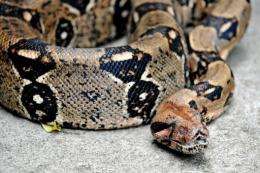Boa constrictors can sense the heartbeat of their quarry as they suffocate it, thus giving themselves the signal to know when the prey is dead, scientists say.
Boa constrictors can sense the heartbeat of their quarry as they suffocate it, thus giving themselves the signal to know when the prey is dead, scientists say.
In a study published on Wednesday in the journal Biology Letters, snake experts at Dickinson College in Carlisle, Pennsylvania pondered how the boa can tell when its target is lifeless and can then be swallowed.
Timing the constriction is vital for these snakes.
Squeezing is a huge drain on their energy reserves, for their metabolic rate rises sevenfold during the operation. And while they are coiled around the prey, they themselves are vulnerable to other predators.
The team used a clever idea -- "warm cadaveric rats" -- to monitor the boas.
These were lab rats that had been humanely killed, frozen and then re-warmed to 38 degrees Celsius (100.4 degrees Fahrenheit) using an electric blanket.
The rodents' bodies were then fitted with two tiny gauges: a sensor to monitor external pressure and a replica heart, comprising a water-filled bulb that was connected by a tube to an external pump, which imitated a heartbeat.
Primed for action, the hi-tech rats were placed within striking range of seven captive-born snakes which had never been exposed to live prey and nine wild-caught counterparts.
The herpetologists carried out three experiments, each time controlling the rat's fake heartbeat, to see how long the boa kept up its squeeze.
When they shut off the heartbeat for 10 minutes, the snakes continued their constriction for another seven minutes or so and then released the rat, presuming it to be dead.
But snakes confronted with a rat with a continuously beating heartbeat doubled the pressure and kept up the squeeze for around 22 minutes.
This is a phenomenal achievement, and the longest ever observed for any snake, says the paper.
Rats without a heartbeat were constricted for about 12 minutes on average. But the snake notably did not adjust its coils or apply periodic bursts of pressure, as it did with rats with a beating heart.
Overall, wild snakes were cannier about how long and how much to squeeze.
"Our findings suggest that the ability to respond to a heartbeat is innate, whereas the magnitude of the response is guided by experience," says the study.
"We suggest that the capacity to improve performance through learning enables snakes to become efficient predators of variable and unpredictable prey animals."
(c) 2012 AFP





















